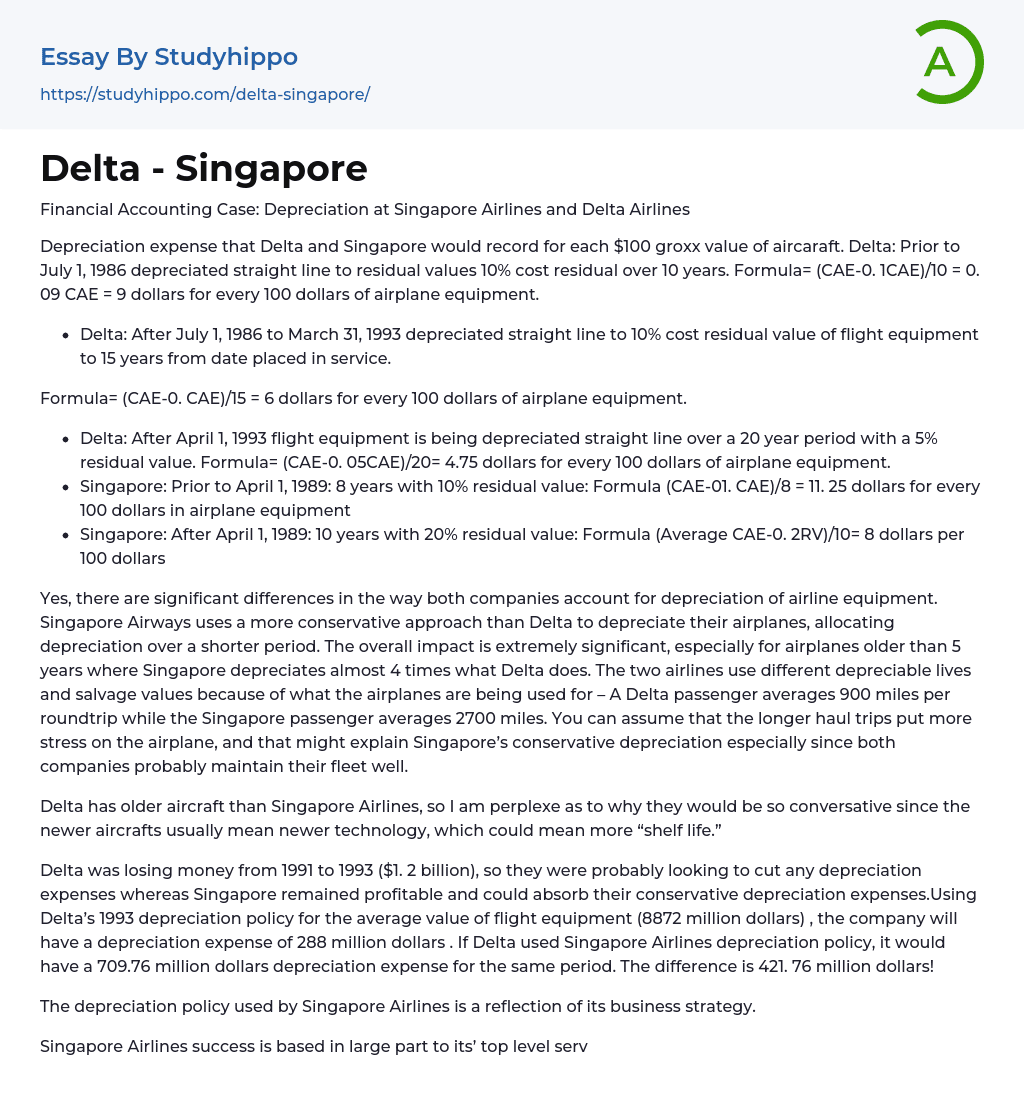Financial Accounting Case: Depreciation at Singapore Airlines and Delta Airlines
Depreciation expense that Delta and Singapore would record for each $100 groxx value of aircaraft. Delta: Prior to July 1, 1986 depreciated straight line to residual values 10% cost residual over 10 years. Formula= (CAE-0. 1CAE)/10 = 0. 09 CAE = 9 dollars for every 100 dollars of airplane equipment.
- Delta: After July 1, 1986 to March 31, 1993 depreciated straight line to 10% cost residual value of flight equipment to 15 years from date placed in service.
Formula= (CAE-0. CAE)/15 = 6 dollars for every 100 dollars of airplane equipment.
- Delta: After April 1, 1993 flight equipment is being depreciated straight line over a 20 year period with a 5% residual value. Formula= (CAE-0. 05CAE)/20= 4.75 dollars for every 100 dollars of airplane equipment.
- Singapore: Prior to April 1
..., 1989: 8 years with 10% residual value: Formula (CAE-01. CAE)/8 = 11. 25 dollars for every 100 dollars in airplane equipment
- Singapore: After April 1, 1989: 10 years with 20% residual value: Formula (Average CAE-0. 2RV)/10= 8 dollars per 100 dollars
Yes, there are significant differences in the way both companies account for depreciation of airline equipment. Singapore Airways uses a more conservative approach than Delta to depreciate their airplanes, allocating depreciation over a shorter period. The overall impact is extremely significant, especially for airplanes older than 5 years where Singapore depreciates almost 4 times what Delta does. The two airlines use different depreciable lives and salvage values because of what the airplanes are being used for – A Delta passenger averages 900 miles per roundtrip while the Singapore passenger averages 2700 miles. You can assume that th
View entire sampleJoin StudyHippo to see entire essay
longer haul trips put more stress on the airplane, and that might explain Singapore’s conservative depreciation especially since both companies probably maintain their fleet well.
Delta has older aircraft than Singapore Airlines, so I am perplexe as to why they would be so conversative since the newer aircrafts usually mean newer technology, which could mean more “shelf life.”
Delta was losing money from 1991 to 1993 ($1. 2 billion), so they were probably looking to cut any depreciation expenses whereas Singapore remained profitable and could absorb their conservative depreciation expenses.Using Delta’s 1993 depreciation policy for the average value of flight equipment (8872 million dollars) , the company will have a depreciation expense of 288 million dollars . If Delta used Singapore Airlines depreciation policy, it would have a 709.76 million dollars depreciation expense for the same period. The difference is 421. 76 million dollars!
The depreciation policy used by Singapore Airlines is a reflection of its business strategy.
Singapore Airlines success is based in large part to its’ top level service and new airplanes.The architecture of the depreciation policy used by Singapore Airlines supports this business plan by creating an incentive for newer fleet by depreciating these less each period than the older airplanes, ultimately increasing profit. They can afford to depreciate their aircraft over shorter periods of time because they can then record the gains on their sale of the aircraft, quite possibly to Delta.
In the case of Singapore Airlines, the age of the fleet makes an important difference.
Airplanes under 5 years will be depreciated over a 10 year period while those older will be depreciated over a 5 year period.The depreciation policy used by Delta is the
same regardless of the age of the airplane. Singapore Airlines tends to sell their aircraft while it still hold much value. Per exhibit 5, they sold their flight equipment, on average, for a gain of $134 million Singapore dollars (appx. $74 million). Whereas, Delta made, on average, $30. 4 million on the sale of flight equipment. By depreciating as they do and using younger aircraft, Singapore Airlines is averaging twice what Delta is on the sale of their flight equipment.
- Airbus essays
- Delta Air Lines essays
- Qantas essays
- Value Chain essays
- Asset essays
- Capital market essays
- Day Trading essays
- Depreciation essays
- Discounted Cash Flow essays
- Foreign Direct Investment essays
- Funds essays
- Futures Trading essays
- Internal Rate Of Return essays
- Million essays
- Revenue essays
- Auction essays
- Balanced Scorecard essays
- Battle essays
- Business Plans essays
- Expense essays
- Income essays
- Intranet essays
- Maintenance essays
- Net Income essays
- Security Guard essays
- Simulation essays
- Singapore Airlines essays
- Bangladesh essays
- China essays
- Hong Kong essays
- India essays
- Japan essays
- Kuala Lumpur essays
- Malaysia essays
- Manila essays
- Pakistan essays
- Philippines essays
- Singapore essays
- Vietnam essays
- Vietnamese essays




